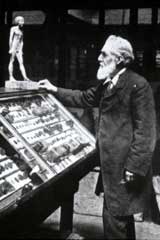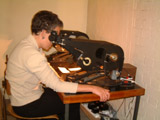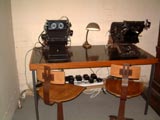| The Museum of Jurassic Technology (MJT) -'Our Inheritance in the Great Pyramid -
God's Cubit', 2001. This was the first UK project by the Los Angeles based Museum of Jurassic Technology (MJT), a hybrid institution which is simultaneously art and museum. MJT's approach has an affinity with the spirit of the earliest form of museum, the cabinet of curiosities, which stimulates wonder in the spectator. Founded by artist and film-maker David Wilson, in 1983, the MJT combines narrative and sound-light projections with finely crafted models and dioramas using computer assisted 3D imagery. Many of the MJT's exhibits are imaginatively reconstructed from accounts in myth, literature and old natural history texts. They make all their museum vitrines and create the electronics and computerised timing devices for triggering the sound and lighting in their displays. This project centred around the 19th century expeditions to Egypt by Sir William Flinders Petrie (1853-1942) and the Astronomer Royal for Scotland, Charles Piazzi Smyth (1819 -1900), to investigate the theory of the that the Great Pyramid was built to 'God's Dimensions'. Even nowadays experts are still baffled as to how the limited technology of the ancient world could produce such a sophisticated structure as the Great Pyramid of Giza. So massive, yet so precise, of the seven wonders of the ancient world, it is the only one to survive. Although many fanciful theories have been put forward, the pyramid debate continues. The MJT's work investigated the metrological findings of Piazzi Smyth who had proposed that the Great Pyramid was built under divine guidance using a 'sacred cubit', thereby initiating the cult of Pyramidology. Flinders Petrie, a former disciple of Smyth, visited Egypt to test and ultimately disprove his theory but was instead to discover his true mission to become the father of 'scientific archaeology'. Amidst the 19th century style display of Petrie's archaeological finds, MJT's installation was sited at the summit of the Museum's unusually steep and shadowy stairway, intended evoke the atmosphere of the Great Pyramid's ascending passage. The installation itself comprised of two viewing stations using specially adapted devices called 'orthoraiders' to present a sequence of stereoscopic and 3D images related to the Great Pyramid of Giza enhanced by audio narratives about these two remarkable characters, Piazzi Smyth and Flinders Petrie. Selected images: 1st image from top: Sir William Flinders Petrie (1853-1942) and the collection of antiquities amassed from his archaeological excavations 2nd image from top: The Astronomer Royal for Scotland, Charles Piazzi Smyth (1819 -1900) who initiated the cult of Pyramidology 3rd image from top: MJT, 'Our Inheritance', 2000 view of installation at the Petrie Museum, UCL 4th image from top: MJT, 'Our Inheritance', 2000 view of installation at the Petrie Museum, UCL To visit The Museum of Jurassic Technology (MJT) website, click www.mjt.org To download edited videoe click here. To download audio narrative about Sir William Flinders Petrie please click here. To download audio narrative about Charles Piazzi Smyth please click here. |
 |
||
| Sir William Flinders Petrie. |
|||
 |
|||
| C. Piazzi Smyth, Astronomer Royal for Scotland. |
|||
 |
|||
| installation showing orthoraiders (viewers) |
|||
 |
|||
| installation showing orthoraiders (viewers) |
|||